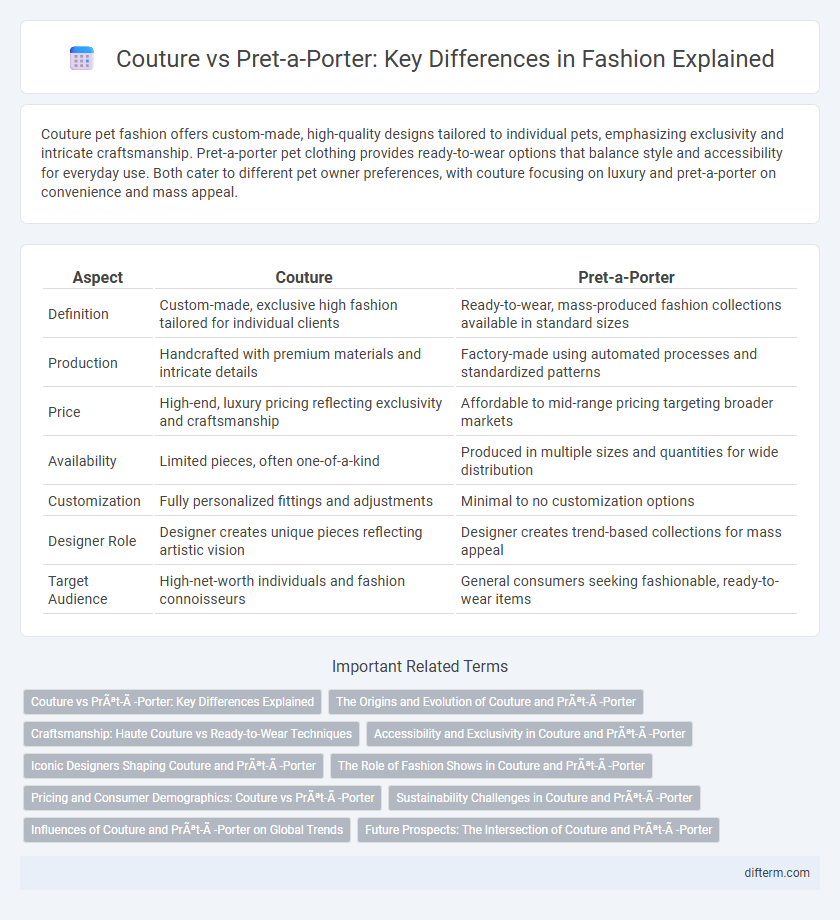Couture pet fashion offers custom-made, high-quality designs tailored to individual pets, emphasizing exclusivity and intricate craftsmanship. Pret-a-porter pet clothing provides ready-to-wear options that balance style and accessibility for everyday use. Both cater to different pet owner preferences, with couture focusing on luxury and pret-a-porter on convenience and mass appeal.
Table of Comparison
| Aspect | Couture | Pret-a-Porter |
|---|---|---|
| Definition | Custom-made, exclusive high fashion tailored for individual clients | Ready-to-wear, mass-produced fashion collections available in standard sizes |
| Production | Handcrafted with premium materials and intricate details | Factory-made using automated processes and standardized patterns |
| Price | High-end, luxury pricing reflecting exclusivity and craftsmanship | Affordable to mid-range pricing targeting broader markets |
| Availability | Limited pieces, often one-of-a-kind | Produced in multiple sizes and quantities for wide distribution |
| Customization | Fully personalized fittings and adjustments | Minimal to no customization options |
| Designer Role | Designer creates unique pieces reflecting artistic vision | Designer creates trend-based collections for mass appeal |
| Target Audience | High-net-worth individuals and fashion connoisseurs | General consumers seeking fashionable, ready-to-wear items |
Couture vs Prêt-à-Porter: Key Differences Explained
Haute couture represents exclusive, custom-fitted fashion created from high-quality, often hand-sewn fabrics tailored precisely to individual clients, exemplifying artistry and craftsmanship. Pret-a-porter, or ready-to-wear, involves mass-produced fashion designed for general retail, offering standardized sizing and greater accessibility. The key differences lie in production scale, pricing, exclusivity, and the level of customization, with couture emphasizing luxury and individuality while pret-a-porter focuses on affordability and trend responsiveness.
The Origins and Evolution of Couture and Prêt-à-Porter
Couture originated in the mid-19th century Paris, pioneered by Charles Frederick Worth, who established the first fashion house creating custom-fitted haute couture garments for elite clients. Pret-a-porter, or ready-to-wear, emerged in the 20th century as a response to industrialization and mass production, offering standardized sizes and more accessible fashion to a wider audience. The evolution of couture and pret-a-porter reflects shifts in society, technology, and consumer behavior, with couture maintaining exclusive craftsmanship and pret-a-porter driving fashion democratization and global trends.
Craftsmanship: Haute Couture vs Ready-to-Wear Techniques
Haute couture epitomizes unparalleled craftsmanship, involving meticulous hand-sewing, intricate embroidery, and custom fittings that ensure each garment is a unique work of art. Ready-to-wear fashion relies on streamlined production techniques, emphasizing machine stitching and standardized sizing to enhance accessibility and efficiency. The distinct difference in craftsmanship between haute couture and pret-a-porter lies in the exclusivity and artisanal detail of couture compared to the scalability and consistency of ready-to-wear collections.
Accessibility and Exclusivity in Couture and Prêt-à-Porter
Couture offers unparalleled exclusivity through meticulously handcrafted garments tailored to individual clients, resulting in high costs and limited accessibility. Pret-a-porter, or ready-to-wear fashion, provides greater accessibility with mass-produced designs available in standard sizes and more affordable price points. The contrast between couture's bespoke luxury and pret-a-porter's widespread availability highlights differing consumer experiences within the fashion industry.
Iconic Designers Shaping Couture and Prêt-à-Porter
Iconic designers like Coco Chanel and Christian Dior revolutionized couture with intricately handcrafted designs defining luxury fashion. Meanwhile, pret-a-porter gained prominence through visionaries such as Yves Saint Laurent and Marc Jacobs, who made high fashion accessible with ready-to-wear collections. The distinct contributions of these designers continue to shape the evolution and global appeal of both couture and pret-a-porter segments.
The Role of Fashion Shows in Couture and Prêt-à-Porter
Fashion shows play a crucial role in showcasing both couture and pret-a-porter collections, serving as key platforms for designers to present their creativity and craftsmanship to global audiences. Couture fashion shows emphasize the exclusive, handcrafted nature of garments made with luxurious fabrics, highlighting the artistry and precision behind each piece. In contrast, pret-a-porter fashion shows focus on ready-to-wear collections designed for wider market appeal, emphasizing trend-driven styles and seasonal versatility.
Pricing and Consumer Demographics: Couture vs Prêt-à-Porter
Couture garments feature exclusive, handcrafted designs with prices often exceeding tens of thousands of dollars, attracting affluent consumers and collectors seeking unique luxury pieces. Pret-a-porter offers ready-to-wear collections with more accessible pricing aimed at middle to upper-middle-class buyers who prioritize style and convenience. The stark contrast in pricing and target demographics highlights couture's role as an investment in artistry, while pret-a-porter emphasizes mass-market appeal and seasonal trends.
Sustainability Challenges in Couture and Prêt-à-Porter
Couture faces sustainability challenges due to its reliance on rare, high-quality materials and intensive handcrafting processes, which generate significant waste and limit scalability. Pret-a-porter, while mass-produced and more accessible, contributes to environmental strain through large-scale manufacturing, fast fashion cycles, and synthetic fabric use. Both sectors are increasingly investing in eco-friendly fabrics, waste reduction techniques, and transparent supply chains to address their distinct sustainability issues.
Influences of Couture and Prêt-à-Porter on Global Trends
Couture's meticulous craftsmanship and exclusive designs set the pinnacle of luxury fashion, often trickling down to influence pret-a-porter collections with refined details and elevated aesthetics. Pret-a-porter democratizes high fashion by making trends accessible and wearable, rapidly shaping street style and mass-market apparel worldwide. The symbiotic relationship between couture and pret-a-porter fuels global trends, blending artisanal innovation with commercial appeal to continuously redefine fashion cycles.
Future Prospects: The Intersection of Couture and Prêt-à-Porter
The future of fashion lies in the convergence of couture and pret-a-porter, where bespoke craftsmanship meets mass-market accessibility through technological innovations like 3D printing and AI-driven design. Luxury fashion houses are increasingly integrating sustainable materials and digital customization platforms to bridge exclusivity with scalability, redefining consumer experiences. This fusion is poised to transform fashion industry dynamics by blending artistry with efficiency, expanding markets without compromising creative integrity.
couture vs prêt-à-porter Infographic

 difterm.com
difterm.com